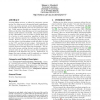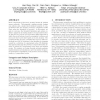80 search results - page 15 / 16 » Attacking and fixing PKCS |
115
click to vote
CCS
2006
ACM
15 years 3 months ago
2006
ACM
Location-hidden services, as offered by anonymity systems such as Tor, allow servers to be operated under a pseudonym. As Tor is an overlay network, servers hosting hidden service...
81
Voted
IANDC
2008
15 years 5 days ago
2008
A multi-party contract signing protocol allows a set of participants to exchange messages with each other with a view to arriving in a state in which each of them has a pre-agreed...
125
click to vote
MOBIHOC
2005
ACM
15 years 11 months ago
2005
ACM
Node compromise poses severe security threats in wireless sensor networks. Unfortunately, existing security designs can address only a small, fixed threshold number of compromised...
ICST
2009
IEEE
15 years 6 months ago
2009
IEEE
GEGICK, MICHAEL CHARLES. Predicting Attack-prone Components with Source Code Static Analyzers. (Under the direction of Laurie Williams). No single vulnerability detection techniqu...
82
Voted
CCS
2008
ACM
15 years 2 months ago
2008
ACM
This paper reconsiders the threat posed by Shacham's "return-oriented programming" -- a technique by which WX-style hardware protections are evaded via carefully cr...



